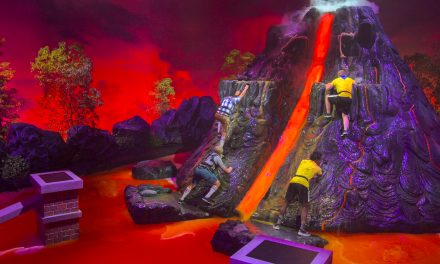
I’ll just start off with this. Michael Mann’s Manhunter is one of the most ripped-off, copied, and influential films of the past 30 years. After it’s release in 1986, the television genre for serial killers, detectives, and anything in between on that spectrum has exploded. Most people think about Hannibal Lecktor (how it’s credited in this film), and think of Silence of the Lambs. I used to think that way. After all, Sir Anthony Hopkins’s performance in that film is one for the ages. However, after watching Manhunter and deliberating, I’m not so sure that’s the quintessential Lecktor/Lecter film.
What does Michael Mann’s Manhunter have going for it? Well, for starters, it’s a Michael Mann film. That has a pedigree of it’s own with style and substance. Also it basically set the tone for 30 years of movies and television after it. The film adapts the novel Red Dragon by Thomas Harris. So this is the first on-screen appearance of Hannibal Lecktor.
It’s cast is fantastic and they all drive the film. From the moody simmer of William Petersen to the truly terrifying and enigmatic performances of Brian Cox as Lecktor and Tom Noonan as Francis Dollarhyde. It’s not a mystery that the audience has to unravel, we just get to go for the ride with Will Graham along the way. In addition to those fantastic performances we get Dennis Farina as Jack Crawford in one of the most subtly badass performances of his career. Joan Allen plays Dollarhyde’s love interest, the blind, Reba McClane. Rounding out the main cast is Stephen Lang as the obnoxious and incessant Freddy Lounds.
Michael Mann wrote and directed Manhunter. The film was produced by the famed Dino De Laurentiis. It’s a true masterpiece of horror and psychology that people need to see.
Laying Bare The Whole Film, Manhunter Is Not Your Traditional Horror Film

I’m classifying Manhunter as horror, you can disagree. While it doesn’t contain truly brutal depictions of murder, monsters, demons, or whatever else you might think goes into a horror film, it definitely causes major unease. If I’m this tense and uneasy watching a film, even after multiple rewatches, something is going right. You’re getting a film school masterclass from Mann while you’re watching the events of the film unfold. All the while, you’re not actually seeing many of the brutal acts of “The Tooth Fairy”, it’s either implied or you’re shown the aftermath.
The basic plot of the film is that Will Graham (Petersen) is a retired FBI Criminal Profiler who had a breakdown due to his time with Hannibal Lektor (Brian Cox). He’s pulled back into duty by Jack Crawford (Farina) to work on a case involving a new killer called “The Tooth Fairy” (Noonan). It’s quite the simple plot that unravels and brings you into the mind of a psycho.
Inevitably, this film gets lumped in with the other Hannibal films. Most notably, Red Dragon, which is adapted from the same novel. Red Dragon is a gratuitous, overbloated film that focuses too much on Hannibal and less on the actual story at hand. That film doesn’t overshadow this one. The main difference between the two is a less heavy-handed approach to story and action in Manhunter. Mann lets the story simmer in this film, while Brett Ratner does not in Red Dragon.
The Implied Is More Powerful In Manhunter

The only times we see the truly debauchery filled acts of violence from Dollarhyde in the film are at the end and when he lights Freddy Lounds on fire. That’s it. Which is the true magic of Manhunter. You’re given the option as a moviegoer to imagine whatever Francis Dollarhyde has done. Bits and pieces are filled in by Will Graham in his findings, but for the most part, it’s up to you. Near the end of the film, we’re given the final act of Francis Dollarhyde before he fully reverts to his serial killing lust. He mistakes Reba being walked home by a co-worker for a loving embrace, and murders the co-worker.
It’s also one of the only serial killer thriller/horror films that shows the killer being humanized by a relationship. After that relationship is shattered by Francis, it’s all over. The real action in the film is in the climax. The final confrontation between Will Graham and Dollarhyde is frightening and tense. It’s all tied up with the mental connection between our hero and the villain of the film.
Hannibal Makes A Mark In A Short Amount Of Time
Meanwhile, you’re treated in the intervening scenes of the film with Brian Cox’s underrated performance as Hannibal. More playful and schoolboy like than Hopkins’s dead-serious performance. It doesn’t match that level, but it comes damn close.
You’re given less than ten minutes of screen-time for Cox as Hannibal. In those ten minutes, you’re given everything you need to see, but also are left asking for more. Which is surely intentional by Mann. The movie is not about Lecktor, but he’s important to the overall character of Will and Dollarhyde. He’s inexplicably linked between the two.
This is a nightmarish world where gore is kept to a premium and everything that you do see, is in the aftermath. The suspense in the film is wrung out slowly.
Outside Of The Story, Manhunter Is Just Beautifully Shot And Haunting

It’s shots like the one above that really add to the mystique of Manhunter. I don’t want to get all “film-school” kid on you, but I’m going to. The story is shown as a mirror of the two characters: Will and Francis. While they might be very different, it’s Will trying to break into the head of Francis to catch him. Doing this with Hannibal almost killed Will before. So there’s an apprehension that you can feel in Petersen’s performance about everything he does. Shots like the one above add to the “mirror image” trend in the film.
When you see Hannibal and Will talking to each other, every shot is framed with the bars between them. But Mann makes sure to have it shown that Will is behind bars as well as Hannibal. The colors in the film are subdued, everything has a dream/nightmare-like state to it. Dante Spinotti and Michael Mann work in tandem here to create one of the best visual atmospheres on film. Hannibal is given a slick white color palette at all times. Dollarhyde’s palette is always a variation on green. Finally, Will Graham’s light blue hues are surrounding him at all times up until the end when he ventures into Dollarhyde’s home.
Many noir films are known for the visual clutter on screen. Manhunter is very much in that noir style of storytelling but it upends the normal visual palette. Mann instead maximizes every shot with as little clutter as possible.
It Remains An Influence To Every Killer/ Noir/Horror Piece To This Day

I’ll go back to the main point that, Manhunter is the single most influential piece of media on the grand genre of serial killers and thrillers for the past 30 years. The film relies on little used techniques by filmmakers these days, instead of just showing the gruesome murders or acts, the audience is trusted to imply or imagine what happened. Shows like The X-Files, CSI, Mindhunter, and many more all owe their lives to this film. Michael Mann might be more known or remembered for Miami Vice or Heat, but this film is his true masterpiece.
Taken for a ride on a dream-like vehicle in Manhunter, it might not be the stereotypical horror film, but it leaves the horror to your own imagination. Instead you’re filled with suspense that builds and builds and then finally explodes in the third act of the film. If you’re a fan of forensic television or films, you owe it to yourself to give Manhunter a fair shake, especially in comparison to it’s more famous Hannibal-led brethren.
For more on THS Fright-A-Thon, check out these horror articles.



